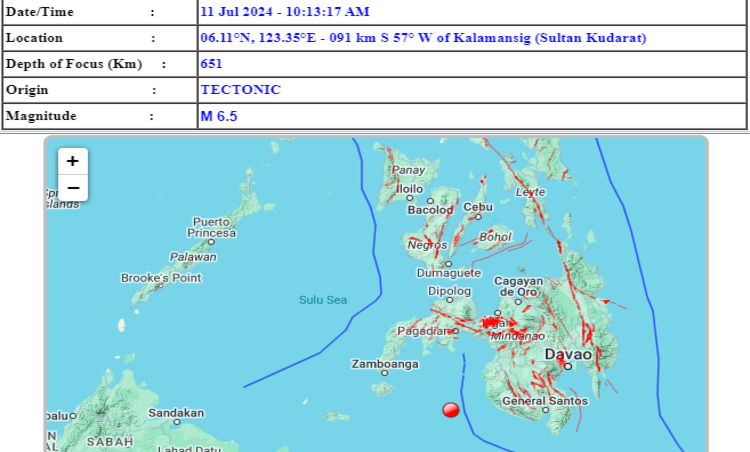On the morning of July 11, 2024, at precisely 10:13 AM, a significant earthquake with a magnitude of 6.5 struck Kalamansig in Sultan Kudarat. The Philippine Institute of Volcanology and Seismology (Phivolcs) reported that the epicenter of this powerful quake was located at 06.11°N, 123.35°E, approximately 91 kilometers south-southwest of Kalamansig.

This seismic event originated from a tectonic movement deep within the Earth’s crust, occurring at a remarkable depth of 651 kilometers. The earthquake’s considerable depth suggests that its effects on the surface might be less severe compared to shallower quakes of similar magnitude. However, the energy released was still substantial, causing widespread concern among residents and prompting immediate action from local authorities.
The region of Sultan Kudarat is not unfamiliar with seismic activity, being situated in a seismically active part of the Philippines. The tectonic plates in this area are constantly shifting, making it prone to earthquakes. This latest tremor serves as a reminder of the ever-present geological risks in the region.
Following the quake, Phivolcs promptly issued advisories to ensure public safety. They have monitored the situation closely and urged residents to stay vigilant for potential aftershocks. The agency also emphasized the importance of preparing for such events, recommending that families review and practice their emergency plans.
Local authorities in Kalamansig and neighboring areas have been mobilizing emergency response teams to assess the impact of the earthquake. Initial reports indicated minor structural damages, but no significant injuries or casualties have been reported so far. Schools, offices, and other establishments have been inspected for safety, and precautionary measures are being implemented to safeguard the community.
The depth and location of the earthquake suggest that its effects might have been felt in various parts of Mindanao. Reports from nearby provinces indicate that the shaking was experienced in cities such as General Santos and Davao, albeit with less intensity. The widespread nature of the tremor highlights the importance of regional cooperation in disaster response and preparedness.
In the aftermath of the earthquake, the local government, along with non-governmental organizations, has been working to ensure that affected communities receive the necessary support. This includes providing temporary shelters, medical assistance, and other essential services to those in need. The collaborative effort aims to mitigate the impact of the quake and help residents return to normalcy as swiftly as possible.
As the situation develops, Phivolcs continues to provide updates and information to the public. The agency’s commitment to monitoring and researching seismic activity is crucial in enhancing the country’s preparedness and resilience against natural disasters. In light of this recent event, it is a timely reminder for everyone to stay informed and prepared for future seismic occurrences.
This 6.5 magnitude earthquake serves as a stark reminder of the unpredictable nature of our planet. While the immediate aftermath appears to be manageable, the incident underscores the importance of continuous vigilance and preparedness in earthquake-prone regions like Sultan Kudarat.
